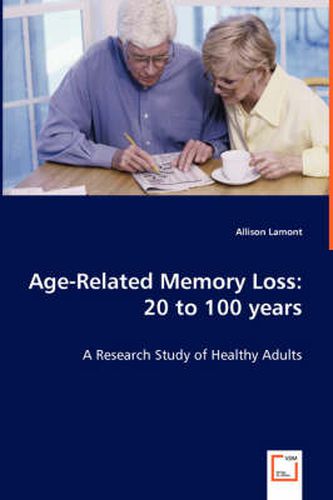Readings Newsletter
Become a Readings Member to make your shopping experience even easier.
Sign in or sign up for free!
You’re not far away from qualifying for FREE standard shipping within Australia
You’ve qualified for FREE standard shipping within Australia
The cart is loading…






This title is printed to order. This book may have been self-published. If so, we cannot guarantee the quality of the content. In the main most books will have gone through the editing process however some may not. We therefore suggest that you be aware of this before ordering this book. If in doubt check either the author or publisher’s details as we are unable to accept any returns unless they are faulty. Please contact us if you have any questions.
What happens to memory during the ninth and tenth decades of life? The research conducted by Dr Lamont challenges the earlier perception that a linear decline occurs from about 40 years of age until late old age. On the contrary, the linear theory was found to be inaccurate for many types of memory. There is good news for those in the 50-70 age group, and beyond that startling variations in memory abilities were found in this study of healthy adults from 20 to 100 years of age. The rapidly aging population will make these findings critical in future planning. Clinicians, legislators, researchers, decision makers in the fields of town planning, retirement, health and community services, and care of the elderly will find the research outcomes fundamental in planning for rapid growth in the 85+ sector of the population. Understanding how this age group will be able to function in society is crucial to the retention of independence and quality of life for our oldest citizens.
$9.00 standard shipping within Australia
FREE standard shipping within Australia for orders over $100.00
Express & International shipping calculated at checkout
This title is printed to order. This book may have been self-published. If so, we cannot guarantee the quality of the content. In the main most books will have gone through the editing process however some may not. We therefore suggest that you be aware of this before ordering this book. If in doubt check either the author or publisher’s details as we are unable to accept any returns unless they are faulty. Please contact us if you have any questions.
What happens to memory during the ninth and tenth decades of life? The research conducted by Dr Lamont challenges the earlier perception that a linear decline occurs from about 40 years of age until late old age. On the contrary, the linear theory was found to be inaccurate for many types of memory. There is good news for those in the 50-70 age group, and beyond that startling variations in memory abilities were found in this study of healthy adults from 20 to 100 years of age. The rapidly aging population will make these findings critical in future planning. Clinicians, legislators, researchers, decision makers in the fields of town planning, retirement, health and community services, and care of the elderly will find the research outcomes fundamental in planning for rapid growth in the 85+ sector of the population. Understanding how this age group will be able to function in society is crucial to the retention of independence and quality of life for our oldest citizens.